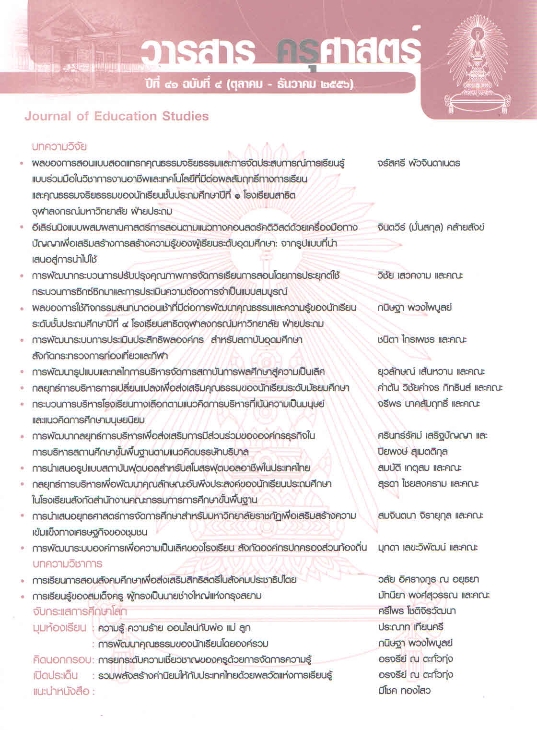การพัฒนาระบบการประเมินประสิทธิผลองค์กร สำหรับสถาบันอุดมศึกษา สังกัดกระทรวงการท่องเที่ยวและกีฬา
Keywords:
ระบบการประเมิน, ประสิทธิผล, ประสิทธิผลองค์กร, EVALUATION SYSTEM, EFFECTIVENESS, ORGANIZATIONAL EFFECTIVENESSAbstract
การวิจัยนี้มีวัตถุประสงค์เพื่อ ๑) พัฒนาองค์ประกอบและตัวบ่งชี้ประสิทธิผลองค์กร ๒) พัฒนา ระบบการประเมินประสิทธิผลองค์กร และ ๓) ประเมินคุณภาพของระบบการประเมินประสิทธิผลองค์กร สำหรับสถาบันอุดมศึกษา สังกัดกระทรวงการท่องเที่ยวและกีฬา กลุ่มตัวอย่าง ประกอบด้วยผู้บริหาร ๑๒ คน คณาจารย์ ๒๕ คน และบุคลากรสายสนับสนุน ๔ คน เก็บรวบรวมข้อมูลจากการสัมภาษณ์ การสังเกตแบบ มีส่วนร่วมและการใช้แบบประเมินวิเคราะห์ข้อมูลเชิงปริมาณด้วยสถิติบรรยายและเชิงคุณภาพด้วยการ วิเคราะห์เนื้อหาผลการวิจัย พบว่า ๑) องค์ประกอบและตัวบ่งชี้ประสิทธิผลองค์กร ประกอบด้วย ๖ องค์ประกอบ ๒๑ ตัวบ่งชี้ ได้แก่ องค์ประกอบที่ ๑ การจัดการเรียนการสอน ๖ ตัวบ่งชี้ องค์ประกอบที่ ๒ การวิจัย ๓ ตัวบ่งชี้ องค์ประกอบที่ ๓ การบริการวิชาการแก่สังคม ๑ ตัวบ่งชี้ องค์ประกอบที่ ๔ การทำนุบำรุงศิลปะและวัฒนธรรม ๑ ตัวบ่งชี้ องค์ประกอบที่ ๕ การบริหารและการพัฒนาองค์กร ๘ ตัวบ่งชี้และองค์ประกอบที่ ๖ การพัฒนากีฬาสู่ความเป็นเลิศ ๒ ตัวบ่งชี้ ๒) ระบบการประเมินประสิทธิผล องค์กรมีองค์ประกอบที่สัมพันธ์กัน ๔ ด้าน ได้แก่ ด้านปัจจัยนำเข้า ด้านกระบวนการ ด้านผลผลิตและ ด้านข้อมูลป้อนกลับและการใช้ผลการประเมิน และ ๓) ระบบที่พัฒนาขึ้นมีความถูกต้องครอบคลุม มีประโยชน์สำหรับการประเมินผลการปฏิบัติงานหลักขององค์กร มีความเหมาะสมและมีความเป็นไปได้ใน การนำไปใช้ได้จริงและผู้บริหาร คณาจารย์และบุคลากรสายสนับสนุนมีความพึงพอใจระดับมาก
The objectives of this research were: 1) to develop the components and indicators of organizational effectiveness; 2) to develop an organizational effectiveness evaluation system; and 3) toevaluate the quality of an organizational effectiveness evaluation system for public higher education institutions under the Ministry of Tourism and Sports. The sample was comprised of 12 administrators, 25 teaching staff, and 4 support staff. Data collection was conducted through interviews, participatory observation, and inquiry using an assessment form. Quantitative analysis employed descriptive statistics and qualitative analysis employed content analysis. The research results showed: 1) Suitable components and indicators of organizational effectiveness comprised 6 components and 21 indicators including the followings: component 1 - instruction with 6 indicators; component 2 - research with 3 indicators; component 3 - social academic service with 1 indicator; component 4- arts and cultural preservation with 1 indicator; component 5 - organizational administration and development with 8 indicators; and component 6 - development of sports toward excellence with 2 indicators. 2) The developed organizational effectiveness evaluation system involved 4 correlated components, i.e. input,process, product, and feedback and utilization of evaluation result. 3) Theresults of the system evaluation were valid,comprehensive, and useful for evaluating the performance of major organizational tasks, meaning the system was suitable and practical and the administrators, teaching staff and support staff were satisf ied.
คำสำคัญ: ระบบการประเมิน/ประสิทธิผล/ประสิทธิผลองค์กร
Keywords: EVALUATION SYSTEM / EFFECTIVENESS / ORGANIZATIONAL EFFECTIVENESS




